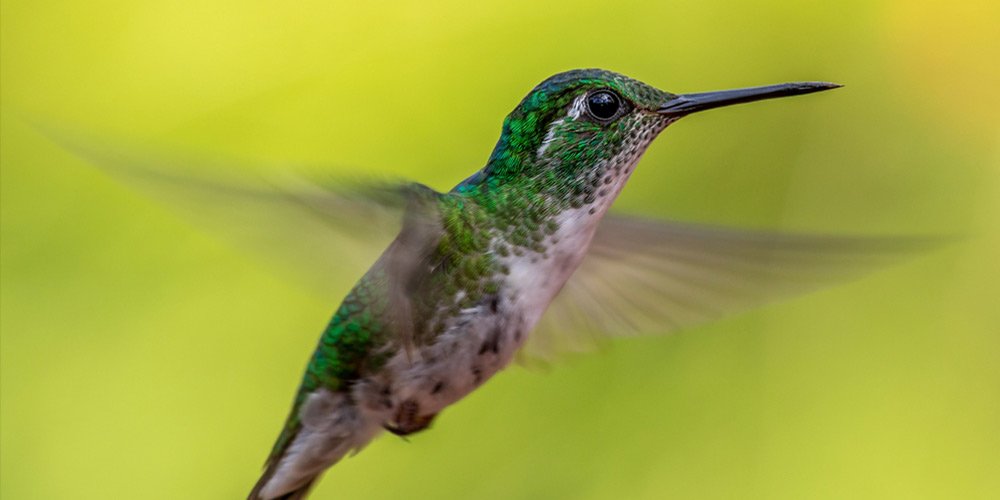Contents [show]
Hummingbirds are small, colorful jewels in the bird world. As usual, the males are more colorful than the females. They have long, narrow bills, blade-like wings, and weigh 2 to 20 grams. Discover Wildlife indicates that they live three to five years. They are related to swifts.
Check out our Hummingbird Live Webcams here >>
According to the Smithsonian, these birds are very agile due to their size and their powerful wings. This provides them with the ability to fly up to 30 mph, remain in flight for 18 to 20 hours, hover, and fly backward or upside-down with a wing beat of 70 times per second while flying and 200 times per second when diving. Their heart rate is 225 beats per minute at rest and 1,200 beats per minute during flight. Due to their high metabolic rate and the poor insulation ability of their feathers, hummingbirds enter a deep torpor state when they sleep. This lowers their metabolism and their 105-degree body temperature.
The walnut-sized hummingbird nests are made with bits of plants and spider webs. They lay one or two eggs that are the size of peas.
If you found your way here, then you know that hummingbirds are considered some of the most beautiful and fascinating birds on planet Earth. These gorgeous creatures are fast-flying, tiny, and very interesting, to say the least. They’ve undoubtedly piqued your interest.
Introduction to the World of Hummingbirds
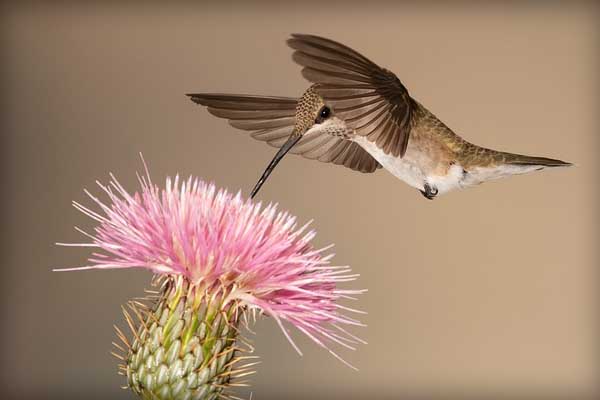
What makes them so special? For starters, they have a unique and distinctive way of hovering in mid-air, which almost looks like they are caught in suspended animation because their wings flap so quickly that it hardly looks like they are even moving. Combine this with their incredible speed and vibrant colors, and hummingbirds are truly a delight.
Unveiling the Vibrant Universe of Hummingbirds
After taking an up close and personal look at hummingbirds in this diminutive guide, you’ll learn about their secrets, discover their unique characteristics, and get a glimpse at their intriguing behavior.
As an enthusiast excited about hummingbirds, it’s only natural to want to learn everything you can about these gorgeous diminutive creatures. We will reward your curiosity by helping you explore their migration patterns, their anatomy, their feeding habits, and much more. Better understanding these aspects of the hummingbirds’ life will help you better appreciate this wonderful species while providing a sense of diversity and fascination for the natural world.
As you keep reading and delving further into this material, you’ll feel enlightened, inspired, and amazed by the information shared about these remarkable birds. Please keep this guide as your go-to resource for everything involving hummingbirds. The topics covered today will provide tailored answers to the most common questions while debunking popular myths.
Are you ready to embark upon an exciting journey into the wonderful world and vibrant universe of hummingbirds? Please begin your journey right now!
Understanding Hummingbird Classification
According to the Smithsonian’s National Zoo & Conservation Biology Institute,
hummingbirds belong to the avian family Trochilidae, and their closest relatives are the equally fascinating swifts. Hummingbirds are small (weighing 2 to 20 grams), with long, narrow bills and small, Saber -like wings.
Next, we will take a deep dive into understanding hummingbird classification. We’ll cover untangling the taxonomy and decoding the diversity of hummingbirds in greater detail below. This includes:
Untangling the Taxonomy: Classification of Hummingbirds
To gain a greater understanding of hummingbird classification, the first step is the most important because you have to become more familiar with their taxonomy.
What is taxonomy? According to Merriam-Webster, taxonomy is “the study of the general principles of scientific classification, especially: the orderly classification of plants and animals according to their presumed natural relationships.”
This formal system of organizing species into groups is a way to classify them based on shared or similar characteristics. As far as hummingbirds are concerned, they are members of the Trochilidae family. It’s made up of over 300 different species.
Next, these species are subdivided even further into several genera. Each genus consists of a group of related hummingbirds.
It shouldn’t surprise anyone to learn that certain Hummingbird species will share similar habits and features. More than likely, this happens because they are members of a common genus. Becoming more familiar with the various Hummingbird genera will make it easier to learn about their subtle differences across the various species of this diminutive bird.
From Genus to Species: Decoding the Diversity of Hummingbirds
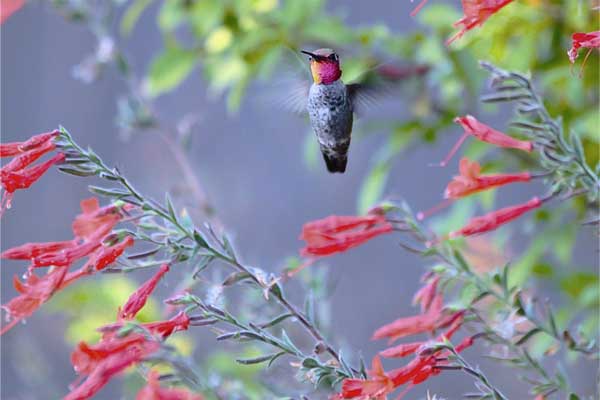
The Hummingbird genera mainly consist of multiple species. Each genus showcases a diversified group of hummingbirds, which each have their own unique treats. Within each of these genera, we narrow down the classification even further to individual species.
To put this in a better perspective, a few different Hummingbird genera and their respective species include:
- Archilochus: Archilochus colubris (Ruby-throated Hummingbird)
- Calypte: Calypte anna (Anna’s Hummingbird)
- Selasphorus: Selasphorus sasin (Allen’s Hummingbird)
To make it easier to differentiate the species within a particular genus, it’s important to pay close attention to their behavior, size, and plumage. Each of these unique features will make it easier than ever to identify different species of hummingbirds.
As you explore hummingbirds and better get to know these wonderful creatures, you’ll find it easier to understand their overall classification system as your knowledge about the species grows. This will help you better appreciate the diversity of these fascinating tiny birds.
Species Spotlight: The Most Common Hummingbirds
With more than three different bird species in the Trochilidae family that are native to the Americas, it’s hard to keep track of them all. On the other hand, there are certainly a few common Hummingbird species as well. They include:
Ruby-Throated Hummingbirds: Tiny Jewels of the Eastern U.S.
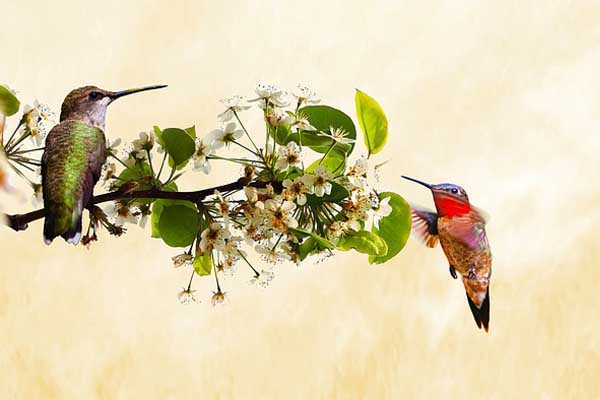
Birdwatchers exploring the eastern part of the United States have undoubtedly encountered the Ruby-throated hummingbird along their travels. These diminutive birds are little jewels with vibrant red throats and iridescent green upper parts. They are so beautiful and it’s a true joy to observe them.
According to All About Birds,
Ruby-throated hummingbirds are bright emerald or Golden-green on the back and crown, with grey-White underparts. Males have a brilliant iridescent red throat that looks dark when it’s not in good light.
Typically, this Hummingbird spends a great deal of time around nectar-rich flowers, including bee balm, Columbine, and trumpet vine flowers. Keep a sharp eye peeled for their nests, which are very small and cup-shaped, which makes them tough to spot at times, but they are noticeably made of materials, including spiderwebs and plant material.
Would you love to attract hummingbirds to your backyard? The Ruby-throated Hummingbird loves drinking sugar water from hummingbird feeders. Never add red dye to the mixture, though, because it is quite harmful to these little birds.
Anna’s Hummingbirds: West Coast’s Year-Round Residents
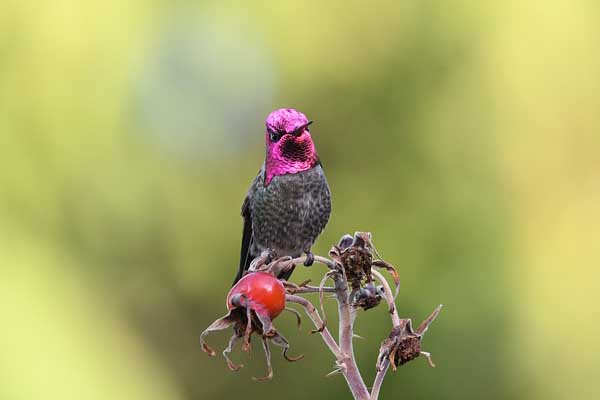
For those traveling or living on the West Coast, you may recognize the familiar Anna’s hummingbirds, which hang around the gardens in the Western states. These residents live here all year round and have greenbacks, rosy-pink throats, and their undercarriage is made up of white feathers.
When compared to the Ruby-throated Hummingbird, Anna’s hummingbird is slightly larger than the other Hummingbird. Typically, you can find these birds in wooded areas, city parks, and gardens all along the West Coast.
According to the National Audubon Society,
this hearty little bird is a permanent resident along our Pacific Coast, staying through the winter in many areas where no other hummingbirds are present.
Would you like to spruce up your backyard to help Anna’s hummingbirds thrive? Consider making the following upgrades:
- Plant nectar-producing plants, including California fuchsia and Salvia, to provide delicious food for these diminutive creatures
- Hang up a hummingbird feeder in your backyard during the coolest months of the year, since finding natural food sources become more difficult during this time of the year
Rufous Hummingbirds: Nomads of the North
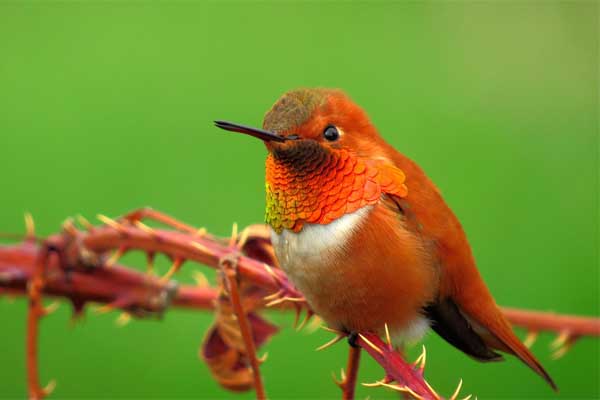
The Rufous hummingbird is best known for its nomadic behavior and is found readily throughout the North American West. This is especially true during the summer months.
Physically, these tiny explorers have rusty-orange color plumage which is quite beautiful. They are also very territorial creatures as well. In fact, they are so territorial that they readily defend their feeding grounds against other birds that try to encroach upon their territory. They even defend their feeding grounds against other hummingbirds that happen to be of different species.
Would you like to witness their feisty behavior up close and personal? You can create a suitable habitat for them in your garden. Plant a wide variety of flowers that contain nectar, including wild current, fireweed, and read Columbine, which will definitely attract these gutsy little birds to your backyard.
Broad-Tailed Hummingbirds: Western North America’s Mountain-Loving Miniature
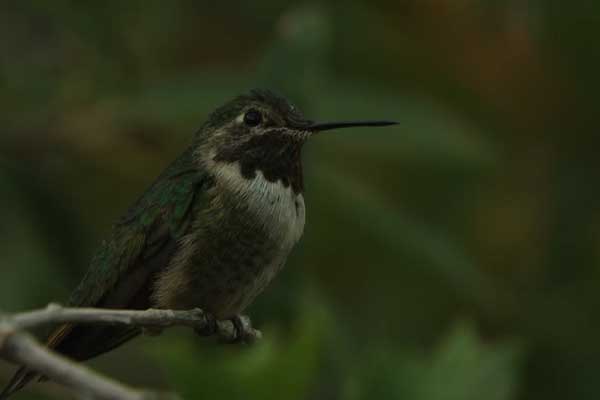
According to Birdwatching Bliss,
The Broad-Tailed Hummingbird is rather long-bodied compared to other North American hummingbirds. Their long broad tail is also conspicuously larger than the rufous and Allen’s.
The adult males are incredibly impressive because their beautiful plumage is made up of a shimmering rose-red gorget, which is similar to a bib but it’s made up of bright red iridescent feathers that look truly amazing.
This diminutive bird also has a green crown and back, which is speckled with greenish-blue feathers. The Broad-tailed hummingbird looks rufous in nature near the tail’s base. The bird’s flanks are green and buffy, and it also has white underparts.
In particular, you love looking at the wingtips of the male because they possess a metallic trill which is very distinctive and helps distinguish this bird from other hummingbirds in North America. If their tips are worn, the trill is often faint or absent altogether.
Its size is as follows:
- Length: 4 inches or 10 cm
- Wingspan: 5.25 inches or 13 cm
- Weight: 0.13 ounces or 3.6 g
Fun fact: during their migration season, the two broad-tailed Hummingbird sexes migrate at different times and they do not migrate together in groups, but individually. And during the migration, the older males are always the first to arrive in their summer or winter habitat, depending on the season, and they are also the first to leave.
Deep Dive: The Lesser-Known Hummingbird Species
The previously mentioned Hummingbird species are more commonly known, as you have undoubtedly learned. But as you can imagine, there are way more lesser-known Hummingbird species as well that are also fun to learn about and quite fascinating.
Here’s a brief introduction to a few of our favorites:
Costa’s Hummingbirds: The Desert Dwellers
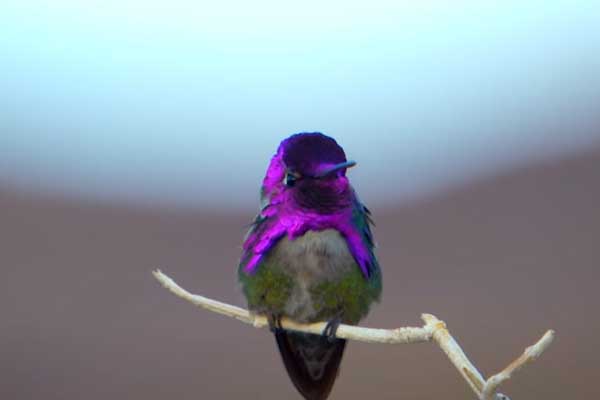
It’s possible to come across a Costa’s hummingbird while exploring the arid regions. This small bird has done a great job of adapting to life out in the desert. In fact, they can survive in harsh conditions because they readily feed on cacti flowers and other desert-grown plants.
According to ebird.org,
this small Hummingbird of desert habitats in southwestern US, western Mexico, and Baja. Compact and short-tailed with a slightly drooping bill.” The male members of the species are very easy to spot because they have distinctive purple throat patches and crowns, which really stand out.
Females, on the other hand, aren’t nearly as bright as their male counterparts. They simply have grayish-green feathers.
These hummingbirds also have quite distinctive mating displays.
Black-Chinned Hummingbirds: Silent Observers of the South
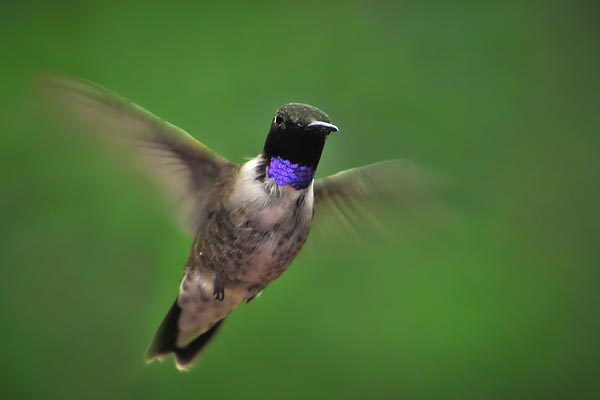
The Black-chinned hummingbird is regularly spotted in the United States in the South and Southwestern regions. Frequently, they spend the bulk of their time in the canyons and woodlands.
They weren’t named Black-Chinned Hummingbirds by accident. They were given this name because the adult males of the species have an understated Black chin, which definitely contrasts with the bright colors typically associated with hummingbirds.
When compared to their relatives, these birds are much less vocal. Typically, when they do vocalize, their songs have been described as low, sweet, and containing a high-pitched warble. Have your whistle through your teeth? Their song kind of sounds like that.
Allen’s Hummingbirds: Coastal Californian Charmers
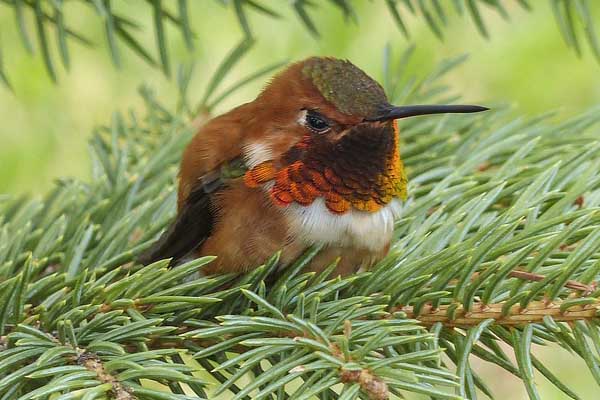
If you’re spending time in the West Coast in the US in the near future, you should stay on the lookout for an Allen’s hummingbird. These birds are incredibly charming and found along California’s coastal areas.
According to Wikipedia,
Allen’s Hummingbird is a small bird, with mature adults reaching 3 to 3.5 inches (76 to 89 mm) in length. The male has a green back and forehead, with rust-colored (rufous) flanks, romp, and tail. The male’s throat is an iridescent orange-red. The female and immature Allen’s hummingbirds are similarly colored, but lack the iridescent throat patch.
Their bright orange throat and copper-toned back make these birds a beautiful sight to behold.
They can be found in many gardens and coastal scrub areas throughout California, which adds a lively presence to the already breathtaking scenery.
Fiery-Throated Hummingbirds: A Striking Costa Rican Beauty
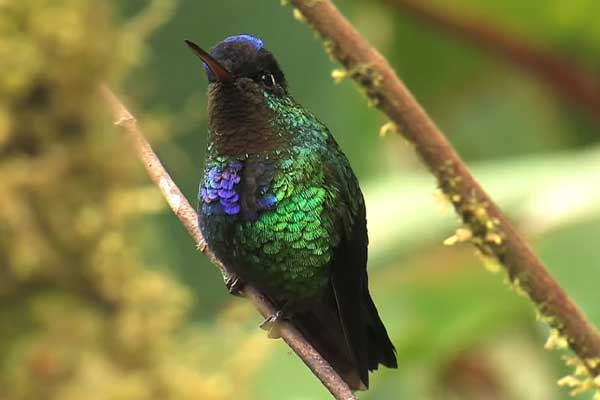
The Fiery-throated hummingbird is vibrant, striking, and found in western Panama and Costa Rica in the cloud forests. It has dazzling plumage to say the least. The males have an iridescent green body that’s totally brilliant, but their throat is covered in a fiery red, which transitions to a shiny blue gorget. The male’s bill is slightly curved and long and it has a forked tail.
Females, on the other hand, aren’t nearly as vibrant as their male counterparts. Their body shape is very similar and it’s predominantly covered with green feathers. The throat is shorter, much less vibrant, and the female fiery-throated Hummingbird doesn’t shimmer nearly as much as the male does.
According to Birds of the World,
The Fiery-Throated Hummingbird is the sole member of the genus Panterpe and is endemic to the highlands of Costa Rica and Western Pennsylvania. To subspecies are recognized, with P.i. eisenmanni being limited to the Cordillera de Guanacaste in the far northwest Costa Rica.
Sword-Billed Hummingbirds: Dominating the Montane Forests of South America
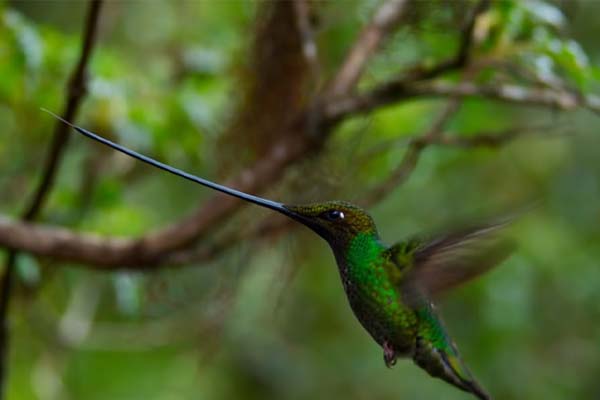
The remarkable Sword-billed hummingbird might be lesser known, but people can automatically pick it out by its long sword-like bill. In fact, its bill is actually longer than the totality of its body length.
As far as appearance goes, this Hummingbird is medium-sized but its extremely long bill is a distinctive feature that you won’t find on most other hummingbirds. Besides the length, the bill is also straight and very slender, which makes it truly resemble a very thin sword.
Otherwise, its plumage is actually dull in color, which is quite different from other hummingbirds as well, at least as far as the males are concerned. The overall color tone of its feathers is shades of green and grey. When compared to other hummingbirds, this one is relatively short in stature.
Frilled Coquettes: Miniature Marvel in the Tropical Rainforests of South America
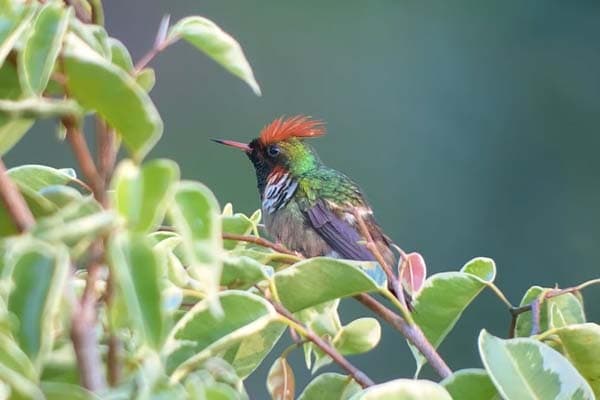
Found in the lowland rainforests and cloud forests of French Guiana, northern Brazil, and Venezuela, the Frilled Coquette bird loves areas with abundant flowering plants and dense vegetation.
This Hummingbird is starting to look at it and it definitely has a very unique plumage. Males in particular look great with their attractive glossy green body and shimmering purple crown. On his forehead, it also has a distinctive frilled crest.
Females also have a green body and a frilled crest, but their crest is much shorter and there coloration is a lot more subdued and it doesn’t have that glossy shimmering look.
Both genders have two things in common. They both have short tails and short bills.
Sparkling Violetears: Dazzling Iridescent Gem in the South American Highlands
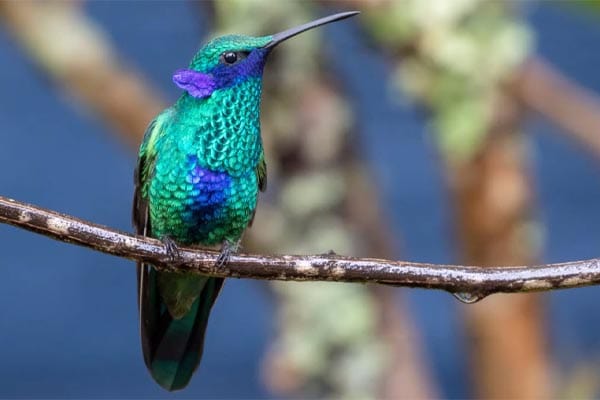
This Sparkling violetear species is quite striking and its iridescent plumage is certainly dazzling to say the least. Males of the species predominantly have a green body, but its throat patch is a vibrant violet-blue that shimmers depending on the lighting conditions. Its tail is for and its bill is relatively short. Females look very similar and have predominantly the same coloration except their gorget isn’t as vibrantly purplish-blue.
It feeds on sweet nectar from flowering plants and also consumes spiders and insects because they are excellent sources of protein. It’s an active and agile bird while flying, it can make quick turns, and it aggressively defends its territory when necessary.
Giants of the Hummingbird World
Within the Hummingbird family, there are a few distinct and unique birds that are a member of this remarkable group. When compared to other Hummingbird species, these birds are well known because of their relatively large size. They also possess distinct characteristics that make them stand out from the crowd.
Here’s a brief introduction to a few giant hummingbirds:
Giant Hummingbirds: The Largest of the Lot
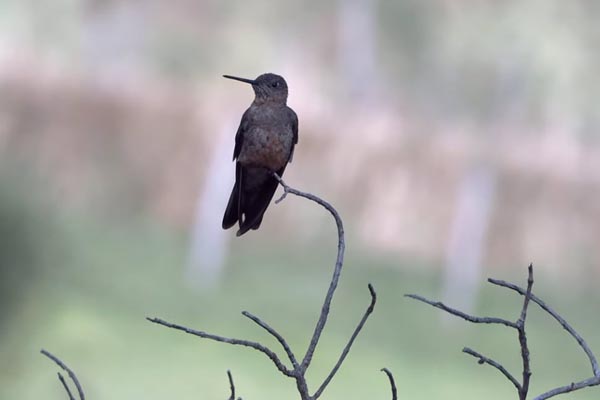
This may seem hard to believe, but when compared to other hummingbirds, the giant hummingbirds are actually around twice the size of their smaller counterparts. This makes this bird species the largest of them all.
They also have a remarkable wingspan, which is around 8 1⁄2 inches. This allows the larger version of the smaller birds to dominate their overall environment. You’ll be very impressed by their larger wingspan, which is a truly interesting sight to behold while watching them hover near a hummingbird feeder and flowers.
These larger birds are considered gentle giants. Their length reaches roughly 8.5 inches for 21.5 cm. Their wingspan is about the same, although it can reach 8.7 inches or 22 cm. Even with their larger size, these birds are quite nimble when they fly. They are also quite adept at hovering over plants and flowers while feeding just like their smaller counterparts.
Patagona Gigas: Titans of the Andes
This bird goes by a few names. Besides being known as a Patagona Gigas, this bird is also called the Andean Hillstar or Giant Hillstar. In fact, this bird is so large when compared to other hummingbirds that it’s considered the largest of its species found within the Andes Mountains.
This bird is so beautiful that it’s quite captivating and it’s fun to watch as it gracefully feeds on the nectar provided by nectar-rich flowers. It’s also important to the flowers of the region because it helps pollinate many of the plants found within its natural habitat.
A brief size description includes the following:
- Length: 8-9 inches
- Wingspan: 7.5-8.5 inches
- Weight: 18-24 g
It’s believed that their size is more distinctive than other hummingbirds because of the high-altitude environment that they tend to inhabit.
Their plumage is truly gorgeous, so keep an eye out for it while looking for these beautiful hummingbirds in the wild. Their feathers are a stunning iridescent color that ranges from various shades of green and blue.
Viewing these large hummingbirds is always a treat. But please remember that they also play a vital role in their overall ecosystem.
White-Tufted Sunbeam: Behemoths of South America’s Southern Tip
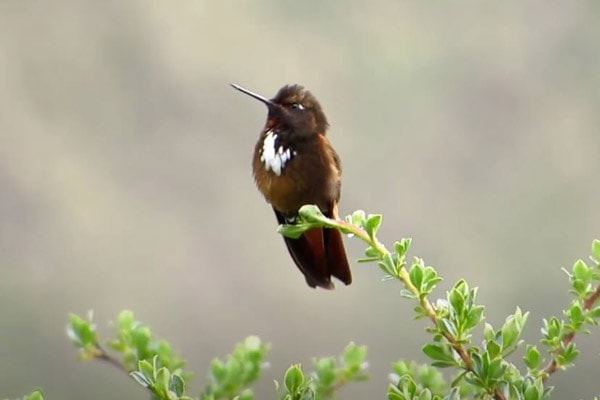
Found predominantly in the Andes Mountains, the White-Tufted Sunbeam is definitely one of the larger Hummingbird species also found in the high-altitude cloud forests of Bolivia and Peru.
As far as appearance goes, and here are some interesting stats:
- Weight – the white-tufted Sunbeam weighs roughly 6-8 g or 0.2 to 0.3 ounces
- Length – the average length of this bird is about 5 inches or 13 cm from the tip of its bill to the end of its tail
- Wingspan – the estimated wingspan of this Hummingbird is 17-20 cm or 6.7 to 7.9 inches in length
Even though it isn’t the largest Hummingbird, it’s definitely above average in size when compared to many of the other more diminutive species.
While feeding, this bird loves to gobble up nectar from various flowering plants throughout its habitat. It’s considered a pollinator, because it transfers pollen from one flower to another, helping to pollinate these plants so that they can grow. Another favorite food source is small insects and spiders because they contain lots of protein.
Finally, this bird has no problem hovering in midair. It can quickly dart from one flower to the next and the males love to put on elaborate aerial displays while courting female hummingbirds. They love to perform implicit flight maneuvers and showcase their vibrant plumage.
Showstoppers: The Most Vibrant Hummingbird Species
With over 300 different types of hummingbirds in existence, it shouldn’t surprise anyone to find out that many of their members are vibrant and dazzling. This species displays a wide-array of so many brilliant colors that it’s difficult to count them all.
It’s never easy to pick the most vibrant because there are many to choose from, but today I’d like to share the most notable contenders with extremely vivid plumage. They include:
Marvelous Spatuletails: The Extravagant Performers
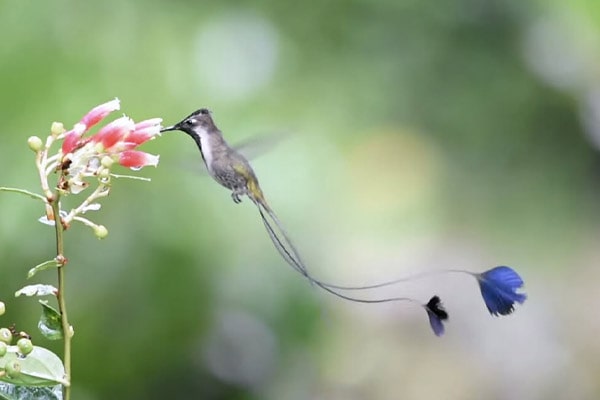
The Marvelous Spatuletails species of hummingbird is truly an amazing sight to behold. These birds are gorgeous, flamboyant, and captivating with their incredibly unique tail feathers.
Interestingly enough, they only have four tail feathers in total, but two of them are extremely long and at the end of these large tales, there are round discs. They love to showcase their wonderful tails during their elaborate performances and mating rituals.
Seeing male Marvelous Spatuletails in action is truly a sight to behold. During courtship, this bird will hover in the air near the females of the species, while extending its feathers in an effort to impress a potential mate.
Their bodies are made up of brilliant iridescent green and blue coloring, which is a complete contrast to their dazzling tailfeathers.
Violet-Crowned Woodnymphs: Crowns of Brilliant Azure
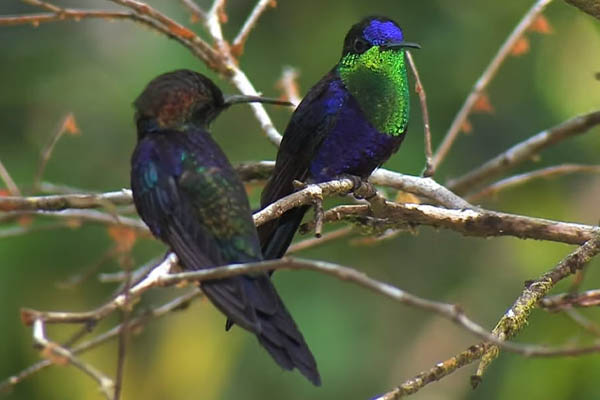
After discovering so many beautiful hummingbirds, you’ll be quite impressed with the Violet-Crowned Woodnymph. This must-see Hummingbird is always a fan favorite because of its glittering violet crowns that have a beautiful shimmering effect in the sunlight.
While observing them closely, their shimmering feathers really stand out because when it comes to the males, they have bright blue bellies and shiny emerald green backs. They look like shiny living and breathing jewels, which is an amazing sight to behold.
On the other hand, the female woodnymphs weren’t as lucky as their male counterparts, because their colors are much more subdued. They have a grayish-white belly, a green back, and a greenish crown, but they do not shimmer nearly as much.
Remember, these show stopping hummingbirds are truly a joy to be around. Their vibrant colors and unique beauty is unmatched in the avian world.
Velvet-Purple Coronet: Captivating the Colombian Cloud Forests
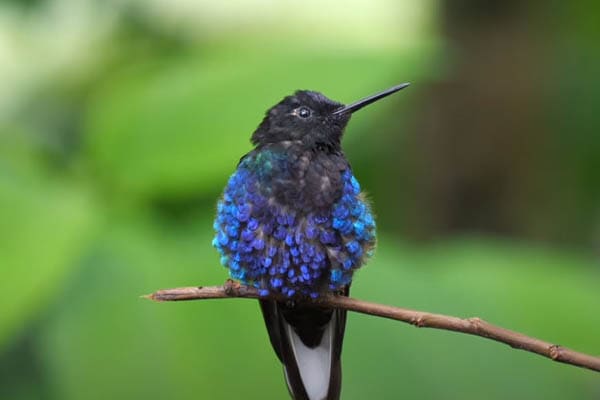
The lustrous purple crown of the Velvet-Purple Coronet is clearly its most outstanding feature. But that’s not all, because it has unique and striking plumage, which adds to the mystery and captivating appearance of this striking Hummingbird.
The males have a deep purple head and throat, which is why this bird was given its name. As far as the rest of the body goes, it has White underparts and iridescent green plumage, which beautifully contrasts with the purple crown. They even have green wings, but it’s a very dark green, so it almost appears black when contrasting with the other colors.
Females, on the other hand, are much less vibrant than their male counterparts. They also have white underparts and green upper parts, but they do not shimmer and shine nearly as much as the males do.
It shouldn’t surprise anyone to learn that their most distinctive feature is the velvet purple crown that gives off a lustrous appearance. It beautifully contrasts with their green body and the purple crown almost looks like a velvet helmet, which gives a distinctive regal appearance to this bird.
The male’s bill is also slightly curved, which is very typical of most hummingbirds. Why? They adapted and developed the curved bill to better feed on tasty nectar.
Coppery-Headed Emerald: Copper Crowns of Costa Rica
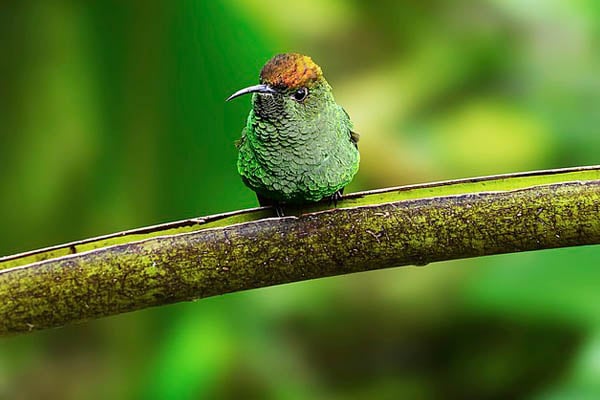
The Coppery-Headed Emerald is a stunning Hummingbird of medium size with distinctive and beautiful plumage. The male members of the species have coppery-red heads, with rustic colors extending all the way to the upper neck, which is how this bird wound up with its name.
The rest of the male’s body has a beautiful green metallic coloration, which has a shimmery metal appearance. This bird has grayish-white underparts and dark tail feathers with white tips.
The females are very similar in body shape and size, but they lack distinctive coppery-red head and neck feathers. In its stead, they have a duller color, which consists of a greenish bronze hue.
Ruby-Topaz Hummingbird: Dazzling Metallic Golden Plumage
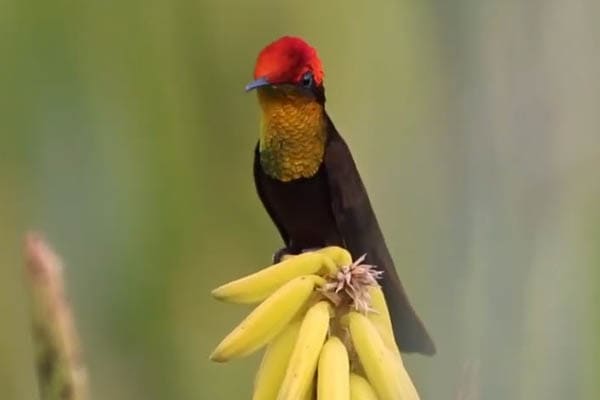
This stunning bird is found in the Caribbean as well as in certain parts of South America. It’s a dazzling Hummingbird with lots of vibrant colors.
In particular, the adult male is quite striking because its feathers possess a brilliant golden or coppery-orange hue in the crown and throat areas. It’s wings and back has a shimmering metallic golden-green color on the feathers, which is also very beautiful to look at.
As far as the tale goes, it’s long and forked. The outer feathers are dark and have white tips, which really make them stand out.
As for the females, their body proportions are very similar to the males, but their color scheme isn’t the same, which is unfortunate for the females of the species. They do not have the same vibrant colors as their male counterparts. In fact, their overall color scheme is greenish in nature and much more subdued.
Other fun facts:
- Habitat – they love living in coastal areas, gardens, and tropical rainforests. They tend to inhabit foothills and lowland areas, but they’ve also adapted to high lead regions as well and live at elevations as high as 4900 feet.
- Feeding habits – these birds love feeding on nectar-rich flowers. They have a long and slender bill, which makes it easy to reach deep within the flowers to extract the nectar quickly. It prefers a wide range of flowering plants, including tubular-shaped blooms. Besides nectar, it’s known to eat spiders, insects, and other protein sources.
- Behavior – Ruby-Topaz hummingbirds are active flyers and quite agile. They can fly in all directions at incredibly fast speeds, plus they have the ability to hover in midair. Males love putting on gorgeous aerial displays during courtship and performing impressive acrobatic feats while making high-pitched sounds with their wings. These territorial birds diligently defend their feeding areas from other hummingbirds.
Hummingbird Habitats: Where These Species Call Home
Hummingbird enthusiasts are undoubtedly curious about the various habitats and different places where these tiny creatures call home. The exciting thing is that hummingbirds are found within a wide range of different environments, including mountain ranges, tropical rainforests, and other diverse habitats.
The next section is more like a brief guide that will explore the various locations that hummingbirds tend to inhabit. After reading this information, you’ll have no trouble pinpointing the various locations that these beautiful birds love to live in.
From Tropical Rainforests to Mountain Ranges: Mapping Hummingbird Habitats
More than anywhere else, hummingbirds make their home in the Americas more than any other part of the world. In particular, they are mostly found in South and Central America.
Why? These beautiful diminutive creatures love living in warmer climates. They are also incredibly resourceful as well, so they can adapt to a number of different types of landscapes across a wide variety of regions.
- Tropical Rainforests – you may Artie know that hummingbirds love to live in lush and tropical rainforests because it’s their preferred habitat. Why? They love this climate because it’s filled with their favorite food sources, including flowers containing sweet nectar, which are available in mass abundance in these locales. Tropical rainforests are made up of colorful habitats that deliver the best conditions for hummingbirds to thrive in, build suitable nesting sites, and eBay predators.
- Mountain Ranges – believe it or not, hummingbirds particularly enjoy living on mountain ranges up at high altitudes, including the Andes Mountains found in South America. These creatures are adaptable and love the high altitude because they are known to live as high up as 14,000 feet above sea level. There is plenty of diverse plant life found at these high elevations, which they certainly appreciate.
- Deserts and Dry Forests – some hummingbirds do not enjoy living in lush rainforests, although many of them prefer them. Costa’s Hummingbird, for example, prefers the dry and arid desert, including the signer and desert found in the southwestern portion of the United States. Another example is the Violet-crown Hummingbird. This Hummingbird prefers the dry forests found in Central America. Both of these bird species have adapted to survive and thrive in the harshest environments, even when water is only available in limited portions.
- Suburban Gardens – up in the northern parts of the United States and Canada, you’ll find that many hummingbirds have actually adapted to living in suburban areas. How so? There are lots of flowering plants in suburban gardens, which many gardeners specifically cultivate to help attract and feed these birds. They love the sweet-tasting nectar-filled flowers found in many backyards across North America and Canada.
Please keep in mind that hummingbirds are found in a wide range of differing habitats. But in particular, the best place to find these birds are areas that are abundant with sources of nectar, which feed them and provide excellent levels of sustenance and energy.
Would you like to attract hummingbirds to your backyard? If you answered yes, then you should definitely make it a point to plant nectar-rich flowers. The best options include bee balm, trumpet vine, and salvia. These plants will absolutely attract your favorite speedy little friends.
Unique Characteristics of Each Species
Identifying Marks: Unique Colors, Patterns, and Traits Among Species
| Species | Unique Colors | Patterns | Distinctive Traits |
|---|---|---|---|
| Ruby-Throated Hummingbird | Bright red throat, green back | White underparts | Only species of hummingbird that breeds in eastern North America |
| Anna’s Hummingbird | Green and gray | Red crown and throat in males | Year-round resident of west coast, extends breeding range after winter |
| Rufous Hummingbird | Bright orange | Some green on back | One of the longest migration routes of any bird species relative to body size |
| Costa’s Hummingbird | Purplish-pink throat, green back | White underparts | Primarily desert dwellers |
| Black-Chinned Hummingbird | Black chin, purple throat, green back | White underparts | Breeds in desert and mountain habitats |
| Allen’s Hummingbird | Orange-red throat, green back | Rufous sides in males | Breeds only along a narrow strip of coastal California and southern Oregon |
| Giant Hummingbird | Brownish, grayish | White strip down the middle of throat | The largest species of hummingbird |
| Marvelous Spatuletail | Green, blue, white | Long tail feathers with large discs (“spatules”) at the end | Found only in a small area of northern Peru |
| Violet-Crowned Woodnymph | Green, violet, white | Violet-blue crown | Found in humid forests from southern Mexico to western Panama |
| Broad-Tailed Hummingbird | Green, rose | Metallic rose-colored throat patch | Found in the western United States and Mexico |
| White-Tufted Sunbeam | Green, blue, white | White tufts of feathers on the side of its neck | Found in the cloud forests of the Andes in Peru and Bolivia |
| Velvet-Purple Coronet | Green, white, purple | Shimmering tailfeathers that reflect light, Velvet-purple crown on head and neck | Found in the Andes cloud forests at elevations between 4900-9800 feet above sea level |
| Coppery-Headed Emerald | Coppery-red, green, white | Coppery-red crown and neck | Found in Montane cloud forests and humid highland forests |
| Fiery-Throated Hummingbird | Green, red, blue, black | Fiery red throat and shiny blue gorget | Found in the Central American highlands of Costa Rica and western Panama |
| Sword-Billed Hummingbird | Green, olive green, pale gray | Long slender bill that looks like a thin sword | Found in the highlands region of the Andes Mountains in South America |
| Frilled Coquette | Green, purple | Distinct shimmering purple crown and frilled crest | Found in the northern regions of South America including northern Brazil, French Guiana, Suriname, Guyana, and Venezuela |
| Sparkling Violetear | Green, violet, blue | Vibrant violet-blue throat patch | Found in the highland regions between Mexico and northern Argentina |
| Ruby-Topaz Hummingbird | Copper, gold, Ruby-red, orange | Ruby-red throat and upper chest, forked tail | Found in coastal areas, gardens, and tropical rainforests in Brazil, Venezuela, Guyana, Trinidad and Tobago, Granada, and Barbados |
Sounds of the Wild: Decoding Hummingbird Calls and Songs
After observing hummingbirds for a while, you’ll undoubtedly notice that they possess a wide range of unique vocalizations. These tiny birds are not only beautiful, but quite communicative and they issue a variety of songs and calls to better express themselves. These songs and calls are also used to relay information to other hummingbirds.
Whenever you see one of the 300+ hummingbirds, do yourself a favor and really listen to their Hummingbird sounds. Pay attention to the different frequencies and tones that they use.
Their tones and frequencies have a wide range including chirps, and high-pitched buzzes, and they’ll even sing multiple notes of complex songs.
By identifying and learning these distinctive sounds, you’ll better appreciate each hummingbird species’ nuances and delve deeper into their fascinating lives. There vocalizations include the following:
- Buzzes – their buzzing sounds are actually a series of short, rapid sounds that they’ll produce while hovering next to food sources. They also produce sound during territorial defenses when invaders are trying to encroach upon their land. Different Hummingbird species produce buzzes of varying pitch and intensity.
- Chirps – when Hummingbird chirps, it produces soft single notes. These notes will vary in their duration, and they will also vary depending on the purpose of the notes between species. In some instances, hummingbirds will chirp to contact their mate. In other instances, they’ll chirp to maintain social bonds or convey alarm if their safety is in question.
- Songs – for the most part, male hummingbirds love to produce songs that are quite complex, which they will sing during their courtship displays. These songs produce intricate melodies that include a variety of trills, chirps and buzzes. Each species usually has its own song, which is a great way to help distinguish between the different hummingbirds.
As you gain more knowledge and understanding of the many Hummingbird species found in the Americas, you’ll have an easier time discovering the interesting world of these small avian wonders. Always keep your ears open and remain on alert for the chirps, buzzes, and songs produced by these captivating creatures.
It shouldn’t surprise anyone to discover that hummingbirds have unique dietary requirements and needs because of their small size and the immense energy required to fly at lightning speeds. For the most part, their diet is made up of flowers and nectar, which gives them a nice jolt of sugar to provide the bulk of the energy that they need.
Nevertheless, hummingbirds tend to supplement their diet with spiders and other insects. They do this to get healthy protein and other essential nutrients needed to survive.
Here’s a brief explanation of the diet of Hummingbird species far and wide:
Dining Preferences: Nectar, Insects, and Beyond
Hummingbird enthusiasts undoubtedly know that these small creatures live off of nectar because it’s their main source of calories and energy. But their diets consist of other food sources as well to provide them sustenance. In fact, to meet their protein needs, they tend to rely on eating spiders and insects.
Interestingly enough, hummingbirds have an incredibly high metabolism as you’ve undoubtedly guessed by their ability to flap their wings so quickly. To maintain this speedy metabolism, they actually have to eat every 10-15 minutes. And as far as nectar is concerned, they have to consume half their body weight worth of this substance in order to thrive.
Their dietary preferences break down in the following manner:
- Nectar – as discussed already, this is their main energy source. They have long and slender bills that were perfectly designed to dig deeply into flowers to gain access to the hidden nectar within. Nectar is mostly made up of sugar, including fructose, glucose, and sucralose. Hummingbirds possess an incredible ability to metabolize sugars and use them as fuel quite rapidly. This helps them maintain their high metabolic rate due to their constant flying.
- Insects and Spiders – although they seem to consume nectar more than any other substance, hummingbirds also add spiders and small insects to their diet to meet their protein and nutrient needs. They are known to capture their prey while hovering next to flowers, literally snatching these insects right out of the year. Or, they will pluck them directly from the leaves of their favorite plants or pull them off of spiderwebs. These birds can easily consume a wide range of insects, including tiny fruit flies or larger beetles and gnats.
- Pollen and Plant Matter – while feeding and greedily gobbling down their favorite nectar, the Hummingbird often consumes pollen and plant matter during this process. Pollen is a good source of protein and amino acids, along with other nutrients, so it certainly doesn’t hurt these birds to consume this substance. They’ll also consume certain types of plant matter, including tree exudates and plant sap, although this is far less common than consuming insects and nectar.
Remember, it’s important to keep in mind that certain hummingbirds may have a different diet depending on food availability, their habitat, and their geographic locations. In some cases, hummingbirds possess specialized bill shapes and various lengths to help them gain access to nectar in certain types of flowers found only in their geographic region. In other instances, the species have adapted to feed on certain insects while also employing foraging techniques to meet their caloric requirements.
By better understanding the dietary requirements of different hummingbirds, it helps us better appreciate their role in the ecology as pollinators and teaches us about the remarkable adaptations that they have to help them survive in diverse environments.
Hummingbird Feeders
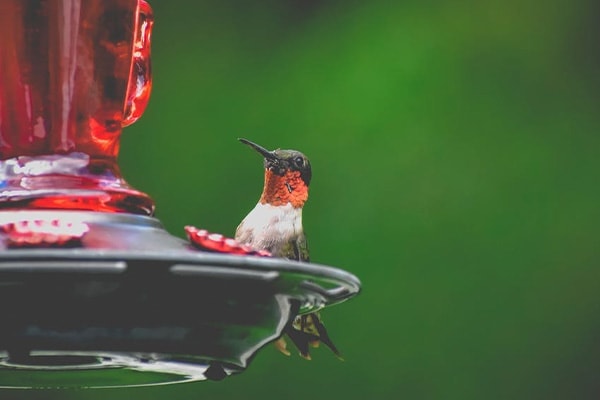
Would you love to attract more hummingbirds to your backyard or garden? Think about installing a new bird feeder specifically designed to feed these tiny and diminutive creatures.
After you’ve hung up your Antique Glass Bottle Hummingbird Feeder in your yard or garden, you need to fill it with a homemade mixture of sugar and water. The mixture should contain four parts of water for every one part of sugar.
Make sure to properly clean and maintain your feeder at all times. Why? If you leave the new feeder uncleaned for too long, it can begin developing mold and the nectar might begin fermenting as well. Neither of these scenarios is very good for hummingbirds. In fact, they can be quite harmful to say the least.
Special Adaptations: How Hummingbird Species Differ in Foraging
After observing many different hummingbirds, it becomes easy to notice their unique foraging adaptations. Some hummingbirds, including the sword-billed Hummingbird, is equipped with a specialized bill. This bill is long and straight, which gives it easy access to nectar within tubular flowers.
On the other hand, the rufous-tailed Hummingbird is equipped with a much smaller bill. This bill is designed to feed on small flowers. Other hummingbirds can hover in the air and catch insects while in mid-flight, showing off their incredible aerial agility.
Keep in mind that every Hummingbird species has its own particular diet and foraging techniques that it prefers. To attract many different types of hummingbirds, and a variety of flowering plants throughout your property and different Hummingbird feeders to accommodate visitors to your yard and garden.
Hummingbird Foraging Techniques Per Species
| Hummingbird Species | Foraging Techniques |
|---|---|
| Ruby-Throated Hummingbird | Hovers to feed on nectar and catches insects in mid-air |
| Anna’s Hummingbird | Sips nectar by hovering next to flowers and drinking from the side or front |
| Rufous Hummingbird | Hovers at the front of the flower, extends long bill into the flour, and takes the nectar. Laps up nectar with specialized tongue |
| Costa’s Hummingbird | Pulls nectar from desert plants including various cacti, agave, and ocotillo, hunts small insects and spiders, and feeds on tree sap from sapsucker’s wells |
| Black-Chinned Hummingbird | Hovers or purchase near flowers to sip the nectar and uses its tongue to lick nectar |
| Allen’s Hummingbird | Probes flowers using its long and slender bill to access nectar hunts insects and spiders from mid-air or leaves and utilizes tree sap another natural nectar source |
| Giant Hummingbird | Feeds on the nectar of large tubular flowers with its long sturdy bill. Catches insects in midair, and uses sapsucker wells to forage for tree sap |
| Marvelous Spatuletail | Uses its long and slender bill to access and feed on flower nectar; forages for insects including gnats, mosquitoes, and flies |
| Violet-Crowned Woodnymph | Uses its bill to probe flowers and drink the nectar and also catches insects and flight |
| Broad-tailed Hummingbird | While hovering, the bird dips its bill into flowers to drink the nectar and also catches insects in flight |
| White-Tufted Sunbeam | Implements rapid flight maneuvers to catch small insects and fees on flower nectar |
| Velvet-Purple Coronet | Hovers or purchase near flowers to access flower nectar and catches flies, gnats, and mosquitoes in mid-air |
| Coppery-Headed Emerald | Uses rapid flight maneuvers to catch small insects and hovers or perches to suck up flower nectar |
| Ruby-Topaz Hummingbird | Feeds on flower nectar from tubular-shaped plants; incorporates small insects into its diet |
| Fiery-Throated Hummingbird | Hovers in front of flowers to sip the nectar and feeds on spiders and small insects |
| Sword-Billed Hummingbird | Extracts insects using its bill and feeds by sucking nectar from long tubular flowers |
| Frilled Coquette | Exhibits a unique foraging technique and extends its bill into the flowers Corolla to access nectar efficiently |
| Sparkling Violetear | Feeds on the nectar of a wide variety of plants; forages for small insects like mosquitoes and gnats |
The Mating Rituals of Different Hummingbird Species
It shouldn’t come as a major shock to learn that different Hummingbird species practice their own mating rituals. To help better understand the courtship process, we’ll look closer at this topic from a couple of different angles that include:
Showcasing Courtship: How Different Species Attract Mates
As you better get to know different hummingbirds, you’ll realize that these creatures are fascinating, unique, and have their own specific mating rituals that differ when compared to various species.
As an example, the male black-chinned Hummingbird loves to perform aerial acrobatics in an impressive display to grab the attention of potential female mating partners. These maneuvers are truly amazing and they contain all kinds of loops, figure-8s, and dives.
In another example, the Ruby-Throated Hummingbird males like to perform a U-shaped dive. This best showcases their prowess and agility to potential female suitors.
The long-tailed sylph, on the other hand, uses its elongated tail to perform unique dances that are very charming to potential mates. It’s truly a sight to behold.
These are just a few examples of the courtship rituals performed by various Hummingbird species.
Parenthood in the Hummingbird World: Nesting Habits Across Species
After a pair of hummingbirds get together, these lovebirds begin to focus on nesting as their top priority. You’ll quickly learn that nesting practices amongst Hummingbird species definitely varies.
For example, the rufous Hummingbird females are the ones to build the nest, while the males collect the materials for the female. They tend to bring moss, plant fibers, and spider silk to build their nest. Afterward, the female will then camouflage the nest and make it cozy by covering it with lichen.
On the other hand, violet-crown hummingbirds work together and institute a collaborating effort during the nest building process. The male and female hummingbirds work diligently to create a safe and comfortable space to lay eggs. They build their nests using soft plant fibers, grasses, and insect silk to create cup-shaped nests.
As you get to know other hummingbirds, remember to pay close attention to their mating rituals and nesting habits. You’ll be pleasantly surprised to learn that they are similar to other hummingbirds and also very different in some cases.
Threats Facing Different Hummingbird Species
Unfortunately, like many birds and creatures that live in the wild, they are under constant threats that could potentially harm their species. Some common threats include:
Endangered Beauties: Threatened and At-Risk Hummingbird Species
It might make you sad to learn that a few Hummingbird species are currently facing extinction. The species that are currently threatened and at-risk include:
- Juan Fernandez Firecrown
- Long-Tailed Sylph
- Ruby-Topaz Hummingbird
- Short-Crested Coquette
The main factors contributing to their overall decline include habitat loss, predation, and the illegal pet trade. You can help these birds by supporting conservation efforts financially, by educating the public on this topic, or by donating your time.
Climate Change and Habitat Loss: The Impact on Hummingbird Populations
You are undoubtedly aware of the impact that climate change has on wildlife habitats and it certainly isn’t good. How does climate change affect Hummingbird populations?
- Rising temperatures possibly alter flowering plant distributions, which could make it difficult for hummingbirds to find their nectar and harm their migration patterns
- Habitat loss is a major challenge due to urbanization and deforestation, which reduces available food resources and nesting sites for hummingbirds
To help save these little birds, do your part to create a welcoming habitat in your backyard. Plant nectar-rich plants and make sure plenty of nesting materials are available for these birds. You can even put up hummingbird feeders and provide sugar-rich sustenance for these little guys.
Remember to always encourage others to protect these little birds as well.
Conserving Hummingbird Species: What’s Being Done and How to Help
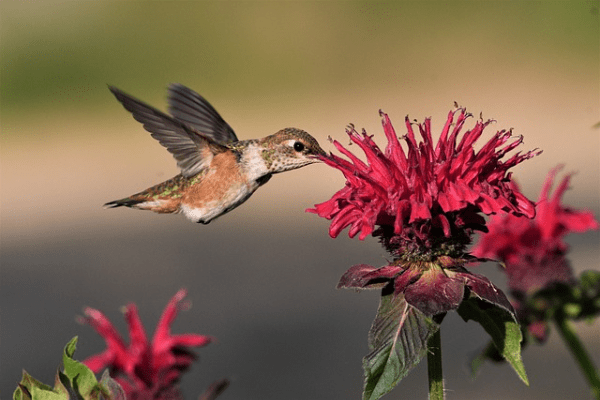
Have you ever wondered about the best way to help hummingbirds through conservation? Below are some helpful tips that include:
The Fight for Survival: Ongoing Conservation Efforts
Conservation programs around North America work hard and tirelessly to preserve habitats and protect Hummingbird species. The American Bird Conservancy and the Xerces Society are two organizations working hard to maintain natural environments by supporting these birds. Their efforts include bird-friendly agricultural practices, public awareness campaigns, and habitat restoration.
The best way to support these organizations include:
- Make donations – these organizations live and die by financial contributions, so help them thrive by donating
- Become a volunteer – connect with a local habitat restoration project and assist them in their efforts to restore the land and make it habitable for hummingbirds. There are also citizen science programs that you can join in your local community as well
- Spread the love – awareness is the key to success, so let everyone know about these conservation organizations and their efforts to preserve and protect hummingbirds. Raise public awareness by sharing this information on social media and other platforms
Becoming a Hummingbird Ally: How You Can Help
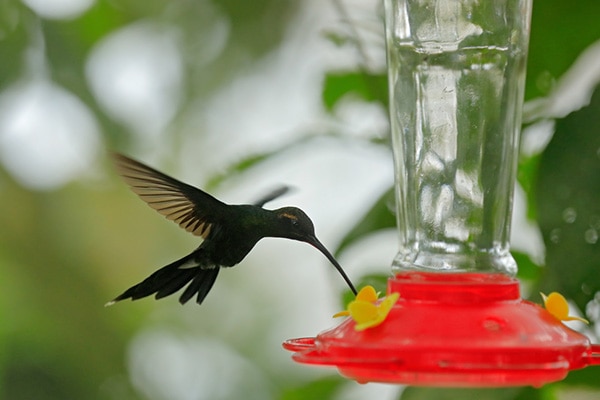
Wouldn’t it be great to become a Hummingbird ally? Wouldn’t you love to know that you helped these birds thrive in their local environment? A few great tips to take to help hummingbirds survive and thrive include:
- Plant a Hummingbird-friendly garden – create a garden in your backyard filled with nectar-rich flowers. Remember to plant flowers that these tiny birds will absolutely love. Their favorites include bee balm, salvia, and trumpet vine.
- Hang up a hummingbird feeder – fill a hummingbird feeder with a mixture of sugar water and hang it up in your backyard. This tasty treat will provide these diminutive birds with an energy boost whenever it’s needed.
- Make nesting materials available – the best way to make nesting materials available is to find a shaded area in your garden and leave these materials out in the open for easy access. They tend to build their nests with animal hair, lichen, and plant fiber
- Create safe spaces – by creating safe spaces, we mean staying away from chemicals and harmful pesticides by never using them in your yard or garden. Cats are dangerous and potentially threatening to these birds, so keep them inside when hummingbirds are around
Become a part of the solution by taking these four simple steps.
By now, it’s quite obvious that hummingbird species are quite diverse in number. In fact, we learned that there are more than 300 hummingbird species in existence today. We only look closer at a smattering of the various Hummingbird species hanging around the Americas.
The Unending Fascination with Hummingbirds: Appreciating Their Rich Diversity
you know as well as I do that these are fascinating creatures that capture the imagination. They have dazzling colors, amazing agility while flying, and an incredible metabolism.
Do you like watching these tiny marbles? Each of the 300 species has unique characteristics and adaptations, which truly make them special. Embrace the Rich diversity of these birds and appreciate the different roles that they play in our ecosystem.
Looking Ahead: Future Research and Conservation Efforts for Hummingbirds
As you look lovingly upon these delightful birds, remember that research and conservation efforts are of the utmost importance to ensure their survival. Always remember to do your part in the following ways:
- Help and support initiatives to preserve their ecosystem
- always promote habitat regeneration
- Become a contributor by creating a hummingbird-friendly garden filled with plant-rich nectar
Become a part of the global movement designed to protect the diversity of these incredible species. The more people get involved, the better chance that hummingbirds will continue to bring joy to all of us from around the world.

